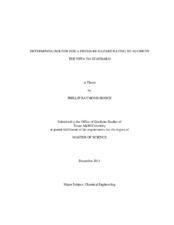| dc.description.abstract | Hazard communication is an essential part of a comprehensive safety plan, especially for those facilities that contain reactive chemicals. There are a variety of means of communicating a chemical hazard, but one of the most prevalent in the United States is the Instability Rating found in the NFPA 704 standard. While the NFPA 704 identifies hazards associated with exothermically decomposing compounds, it neglects compounds that decompose endothermicly to form large quantities of gas. Such compounds have been known to cause accidents due to pressure buildup, such as in the BP Amoco Polymers explosion in 2001.
In this work, twenty-five compounds were examined via an APTAC to determine their pressure and temperature profiles. These profiles were then used to determine the amount of gas generated, the gas generation rate, the gas generation product, the onset temperature, and the instantaneous power density. These properties were analyzed to determine those that best represented the instability hazard of the chemical. Ultimately, the molar gas generation rate and onset temperature were chosen to rate the selected chemicals, and new cut-offs were established to divide the chemicals into revised instability groupings.
Compounds that did not decompose in the temperature range examined were given the rating of zero. Compounds with low onset temperatures and high gas generation rates were assigned the rating of 4, while chemicals with high T_onset and low dn/dt_maxn were assigned a value of 1. Chemicals with high onset temperatures and high gas generation rates were grouped into rating 3. Group 2 included low onset temperature compounds with low gas generation rates. The cut-offs used to define these regions were 130 degrees C for the onset temperature and 0.01 (1/min) for the gas generation rate. The ratings were found to be comparable to the current NFPA system, but improved upon it by providing a valid rating (group 1) for the chemicals that endothermically generated gas. Detailed plots of the data are provided as well as suggestions for future work. | en |


